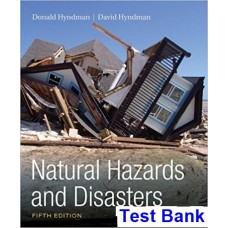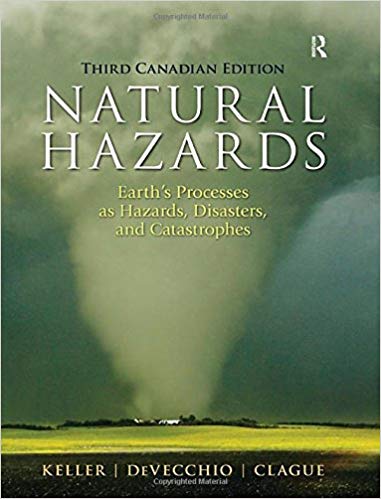Natural Hazards and Disasters 5th Edition By Hyndman – Test Bank
Chapter 6
|
1. A hot rock deep in Earth may melt if it is subjected to an increase in pressure. a. True b. False ANSWER: False REFERENCES: Introduction to Volcanoes QUESTION TYPE: True / False KEYWORDS: Bloom’s: Remember |
|
2. The viscosity of different types of magma is controlled by the peridotite content. a. True b. False ANSWER: False REFERENCES: Introduction to Volcanoes QUESTION TYPE: True / False KEYWORDS: Bloom’s: Remember |
|
3. Most hazardous volcanoes occur near subduction zones. a. True b. False ANSWER: True REFERENCES: Tectonic Environment of Volcanoes QUESTION TYPE: True / False KEYWORDS: Bloom’s: Remember |
|
4. Basaltic magma generally produces non-explosive eruptions. a. True b. False ANSWER: True REFERENCES: Volcanic Eruptions and Products QUESTION TYPE: True / False KEYWORDS: Bloom’s: Remember |
|
5. Most volcanic ash consists of curved shards of glass. a. True b. False ANSWER: True REFERENCES: Volcanic Eruptions and Products QUESTION TYPE: True / False KEYWORDS: Bloom’s: Remember |
|
6. Pahoehoe lava has a ropy, smooth, or billowy surface. a. True b. False ANSWER: True REFERENCES: Volcanic Eruptions and Products QUESTION TYPE: True / False KEYWORDS: Bloom’s: Remember |
|
7. Volcanic ash is always injected into the upper atmosphere and therefore, does not immediately affect the area around the eruption. a. True b. False ANSWER: False REFERENCES: Volcanic Eruptions and Products QUESTION TYPE: True / False KEYWORDS: Bloom’s: Remember |
|
8. Shield volcanoes are characterized by steep slopes. a. True b. False ANSWER: False REFERENCES: Types of Volcanoes QUESTION TYPE: True / False KEYWORDS: Bloom’s: Remember |
|
9. Stratovolcanoes are generally the smallest category of volcanoes. a. True b. False ANSWER: False REFERENCES: Types of Volcanoes QUESTION TYPE: True / False KEYWORDS: Bloom’s: Remember |
|
10. Lava domes and continental calderas cannot produce pyroclastic flows. a. True b. False ANSWER: False REFERENCES: Types of Volcanoes QUESTION TYPE: True / False KEYWORDS: Bloom’s: Remember |
|
11. Volcanic eruptions are likely to be more explosive for magmas that have ____. a. high viscosity and a low amount of volatiles b. high viscosity and a high amount of volatiles c. low viscosity and a high amount of volatiles d. low viscosity and a low amount of volatiles e. any viscosity with a high amount of volatiles ANSWER: b REFERENCES: Introduction to Volcanoes QUESTION TYPE: Multiple Choice KEYWORDS: Bloom’s: Understand |
|
12. The two most abundant gasses in magmas are ____. a. sulfur dioxide and carbon dioxide b. water vapor and oxygen c. oxygen and carbon dioxide d. methane and carbon dioxide e. water vapor and carbon dioxide ANSWER: e REFERENCES: Introduction to Volcanoes QUESTION TYPE: Multiple Choice KEYWORDS: Bloom’s: Understand |
|
13. Compared to other types of magma, basalt ____. a. has lower viscosity, but equivalent silica content b. has lower viscosity and higher silicate content c. has higher viscosity and lower silicate content d. has higher viscosity and higher silicate content e. has lower viscosity and lower silicate content ANSWER: e REFERENCES: Introduction to Volcanoes QUESTION TYPE: Multiple Choice KEYWORDS: Bloom’s: Understand |
|
14. The volume of magma expelled in an eruption depends on ____ of the magma. a. the temperature and volatiles but not the viscosity b. the temperature and viscosity but not the volatiles c. both the viscosity and volatiles d. only the volatiles e. the temperature, viscosity, and volatiles ANSWER: c REFERENCES: Introduction to Volcanoes QUESTION TYPE: Multiple Choice KEYWORDS: Bloom’s: Understand |
|
15. When comparing the characteristics of common magmas or lavas, ____. a. rhyolite has the lowest water content b. andesite has the lowest viscosity c. basalt has the highest silicate content d. rhyolite has the highest viscosity e. basalt has the lowest temperature ANSWER: d REFERENCES: Introduction to Volcanoes QUESTION TYPE: Multiple Choice KEYWORDS: Bloom’s: Understand |
|
16. Which type(s) of magma result in erupted material that is mostly in the form of ash? a. rhyolite only b. andesite only c. basalt only d. both andesite and basalt e. both basalt and rhyolite ANSWER: a REFERENCES: Introduction to Volcanoes QUESTION TYPE: Multiple Choice KEYWORDS: Bloom’s: Understand |
|
17. Basaltic magma eruptions usually take which form? a. lava flows b. pale ash flows c. lahar d. steam-rich explosions e. ash-rich explosions ANSWER: a REFERENCES: Tectonic Environments of Volcanoes QUESTION TYPE: Multiple Choice KEYWORDS: Bloom’s: Understand |














Reviews
There are no reviews yet.